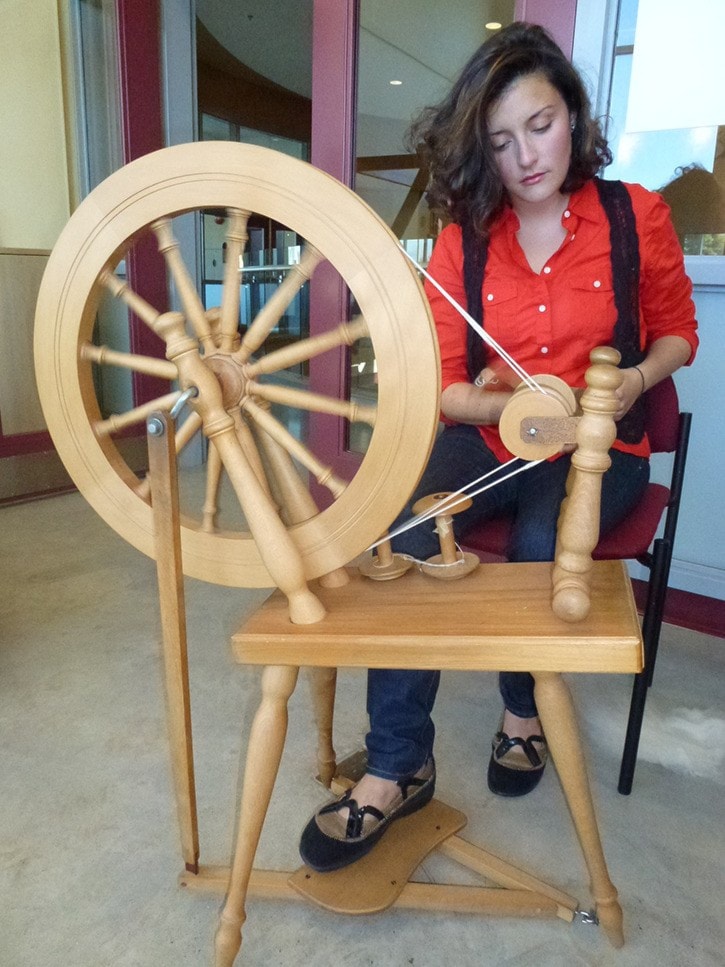The organization may have been around for a long time – but it’s proven as durable as a well-woven fabric.
Peace Arch Weavers and Spinners Guild’s (PAWS) annual Fibre Flare sale and exhibit returns Oct. 20-21 (10 a.m.-4 p.m. each day) at Ocean Park Community Hall, 1577 128 St. – offering a full range of one-of-a-kind handwoven, handspun, felted and knitted items.
And – as a theme wall in the exhibit will point out – the official history of the organization goes back all of 45 years.
“But it was probably going on longer than that with the founding members before they formally established it,” noted PAWS’ Inge Langmann at a pre-show preview at Surrey Museum, where the organization keeps, and works on, its looms and spinning wheels, built to traditional designs that date back as far as the medieval period.
It’s already been six years since PAWS moved to the museum from its former home at the Stewart Farmhouse on Crescent Road, Langmann added.
“We were probably there for the better part of our existence,” she said. “But when the city built the new museum, we were offered this space – and we have a meeting room in the archives, too.”
The change in venue has not had a negative impact on membership, which has historically drawn from White Rock, Surrey, Langley and Washington State, Langmann said.
“We now have 90 members, so we’re growing by leaps and bounds,” she said.
“A lot of younger people have joined, a lot of housewives. Some like basic weaving and spinning, and some are very artistic in what they’re doing.”
Many of the products of members’ will be on sale at Fibre Flare, Langmann said, but buyers can be assured that every item has undergone rigorous jurying before going in the show.
“We don’t judge on artistic merits, but we look at craftsmanship and how the work is finished,” Langmann said.
“And all the items are washed, so whatever shrinkage is going to occur has already happened.”
Typical of the new blood that has come into the guild is Lindsay Gorman, who was encouraged to join in March by her aunt, Jeanette Banta, a keen weaver.
“I’ve been a big knitter for a long time,” she said. “I got into a car accident and got stuck at home – in fact my mom says I knitted my brain back together, because I had a brain injury from the accident.”
Exposure to historic techniques of weaving and spinning through the guild soon provided a new obsession, she said.
“If you want the wool, you’ve got to spin, and if you want to spin, you’ve got to dye, and if you want to dye, you’ve got to weave,” she said of the progression.
“I’d say by the look of my fibre closet it’s an addiction – but it’s a historical addiction. People became addicted to it out of necessity.”
Working with weaving and spinning also has a tangible appeal that is not like the click, click, click of virtual reality, Gorman said.
“When the power has gone out, we don’t stop working,” Langmann observed.
“It’s self-sustaining,” Gorman said. “A lot of young women are getting off Facebook – they want to get together and knit and have a community.”
“It was bound to happen,” said Langmann. “Everything goes in a cycle.”
Ironically, some of the traditions PAWS is preserving can be seen as forerunners of the computer age.
The Jacquard loom at the Surrey Museum, for example is a replica of the original invented in France in the late 1700s, which used a hole card system to control the loom harness, reproducing the same decorative pattern consistently.
“When we do tours, we tell the kids that’s the beginning of computers,” Langmann said. “They’re always amazed.”
But the history of weaving goes back centuries before that – and the basic loom arrangement of harness and pedals has not really varied since ancient times, Langmann said.
“I think it all started when people started to settle down and become farmers,”: she said. “They started caring for animals and there was the question of what to do with the wool when they sheared the sheep.”
“We know they were spinning flax for the Pharaohs,” said PAWS member Elly Tompe.
“The mummies were wrapped in linen – every culture had weaving at one point or another.”
